You are currently browsing the indies category
Got an early morning doctor’s appointment, so I’m not staying up late to do a full ’80s indie entry, but I wanted to address a couple of questions from the last post.
First, in regards to my inability to recall where else Dalgoda had appeared, Damien rushed in to the rescue:
“There was a Dalgoda story in issue 4 of the British anthology A1 by Jan Strnad and Kevin Nowlan. That might be the one-off you were thinking of.”
Yup, that’s the one. I have it (the full British run, and the later Marvel/Epic mini…didn’t follow the later ones), and I could picture some of the art in my head, which is how I knew it wasn’t original artist Dennis Fujitake on the story. But Nowlan is a good replacement. At this late date I can’t recall the actual plot, but I do remember being surprised to see the character again, even if it was just for a bit.
Customer Sean asks, hopefully facetiously
“Did Cutey Bunny and Omaha the Cat Dancer ever have a crossover story?”
While it’s possible they were both in the same jam drawing or something somewhere, as far as I know the two characters never met. Certainly the tone between the two is different (Cutey Bunny being very silly gag-filled stories vs. Omaha’s melodrama) and the naughtiness levels were certainly night-and-day (Cutey at most a little risque with no nudity, Omaha just full-on tab-A-into-slot-B action). So beyond the superficial element of each being sexy anthropomorphic animal types, they’re quite different.
Brad Walker notes
“You won’t get all the jokes in Laffin’ Gas #5 if you haven’t read Boris the Bear #1; likewise, you won’t appreciate the opening of Boris the Bear #8 (Return of the Ninja Critters) if you haven’t read LG#5.”
Well, I have read and enjoyed all of Boris the Bear, still one of my favorite runs. As such, I should get all the jokes in the LAffin’ Gas parody…which I should have in my hands Any Day Now as I found a run of issues #1-5 for cheap on the eBay. And I’m looking forward to seeing how that parody enriches the experience of Boris the Bear #8.
Which reminds me I made a…“joke” on Twitter about how I wanted to get a complete collection of 1980s black and white boom comics, sorta inspired by my purchase of those Laffin’ Gases. Now I’m likely just going to keep the #5, but I’ll look through #1-4 but those are probably destined for resale in my shop. I seem to do okay with these black and white books of the period. But all this, thinking about b&w boom books, doing the ’80s book thing here, has got me in a nostalgic mood, and those boom books are scratching that itch a little.
How far am I going to go? I mean, I have been on a search for Shadow of the Groundhog for quite some time. I imagine more will come up. I’m pretty sure I have an issue or two of Geriatric Gangrene Jujitsu Gerbils in the shop right now…will I keep them? Will I start seeking out those elusive issues of Fat Ninja? We’ll see!
Anyway, Brad has a link to a review of Laffin’ Gas #5 from a few years back in case you don’t have a copy for your own perusal.
That’s it for now, back Friday for more ’80s books!
Back to addressing your picks for best 1980s indie comics, as I continue to look at the books that got one “vote” apiece. Again, I always like to emphasize this isn’t a reflection of their quality, but rather a demonstration of just how much good stuff was coming out in that particular period of time. Thanks, my friends, for indulging this nostalgic walk through what was a fun time for me personally to be collecting comics.
First, a brief update on my Boris the Bear entry, where I couldn’t recall the name of the parody comic that parodied Boris, itself a parody book. Well, it’s reader Brad to the rescue, as he came up with what my rapidly declining brain could not and reminded me that it was Laffin’ Gas #5 from Blackthorn Comics in 1987:
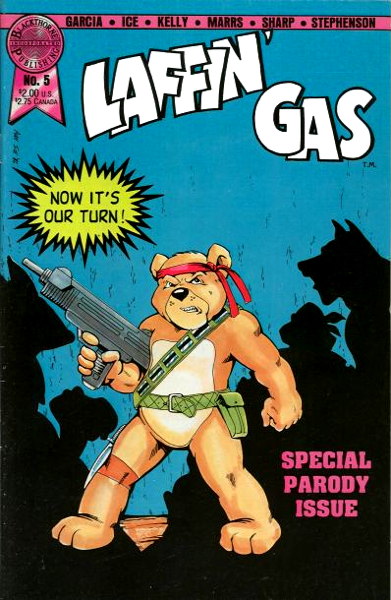
I think I see a Teenage Mutant Ninja Turtle and Dalgoda (more on Mr. Dalgoda in a moment) in the background there. This is one of those comics I didn’t ever really consider picking up when we had plenty of copies at the old shop, but now those are all long gone, I desperately want one. I’m probably going to have that problem with several comics in our Final ’80s Countdown here. Ah well. Thanks, Brad, for letting me know.
So here we go with today’s three ’80s series:
Critters (Fantagraphics 1986-1990)
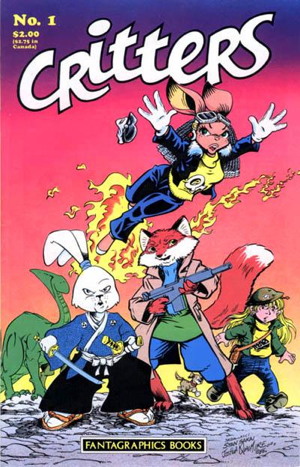 Well, here’s another comic which had an issue I could have bought from the old shop for relatively dirt cheap, but just never got around to it. It’s that first issue, pictured right here, which I wanted for the Cutey Bunny content, but is now apparently a Hot Collector’s Item because of ol’ Usagi Yojimbo there.
Well, here’s another comic which had an issue I could have bought from the old shop for relatively dirt cheap, but just never got around to it. It’s that first issue, pictured right here, which I wanted for the Cutey Bunny content, but is now apparently a Hot Collector’s Item because of ol’ Usagi Yojimbo there.
Despite that disappointing omission from my collection (I actually went into what’s left of the vast Mikester Comic Archives to see if I did have it and just forgot), I do own scattered issues from the series. Most notably I have issue #23, containing the flexidisc with “March of the Sinister Ducks” (lead vocals: one Alan Moore), mentioned waaaaay back on this site in this probably link-rotted post. And I have this “Not the Adventures of Captain Jack” issue from the latter part of the run where they deemphasized the Critters logo in favor of the title of the featured story.
I notice I haven’t made it clear exactly what Critters is, exactly. It’s a black and white anthology series featuring funny animal and anthropomorphic stories by a whole lotta creators, including stories over several issues with the aforementioned Usagi Yojimbo by Stan Sakai. Also of note is Steven Gallaci’s “Birthright,” “Ambrose” by William Van Horn, “Gnuff” by Freddy Milton, a couple of Sam & Max stories by Steve Purcell…the list just goes on and on. And the more I look at the comics database entry for the series, the more issues I find I wish I’d bought. Sheesh.
But this was a solid anthology book containing lots of great work, at least based on the issues I do own, and based on what I’m seeing in my research, so it’s well worth sampling an issue or two. The extra-sized last issue, #50, is an excellent sampler.
Crossfire (Eclipse 1984-1988)
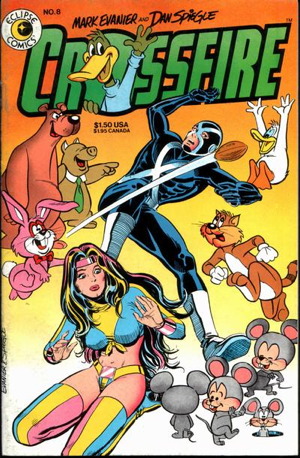 I like Mark Evanier’s writing. I like Dan Spiegle’s art. So why didn’t I read this series? Because I’m a dummy, I guess.
I like Mark Evanier’s writing. I like Dan Spiegle’s art. So why didn’t I read this series? Because I’m a dummy, I guess.
This spin-off from the super-team series DNAgents stars Jay Endicott, bail bondsman, who has assumed the identity of a deceased costumed villain to fight crime from the inside, which I’m gathering from the Wikipedia entry I have open in another tab. Well, okay, actually I did know at least some of that just from simple comic-selling osmosis and handling these books for years and years. But as I said, this remains a huge hole in my reading as there is nothing about this series that doesn’t say “Mike would enjoy this immensely.” Seems like many storylines revolve around showbiz-type material that Evanier knows quite well, something I quite enjoyed in the later Hollywood Superstars series.
There’s also a mini-series called Crossfire and Rainbow (Rainbow being a DNAgents member and Crossfire’s girlfriend, pictured on the cover here). I suspect most of these comics are fairly inexpensive to find, with the exception of issue #12 with the Marilyn Monroe cover by Dave Stevens. Darn you and your talent, Dave Stevens!
Dalgoda (Fantagraphics 1984-1986)
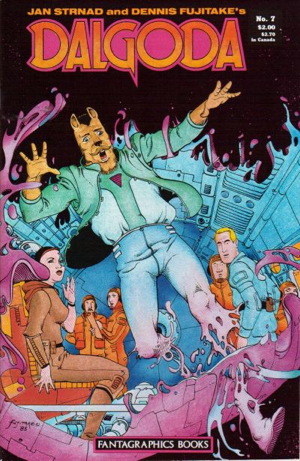 Okay, this series I read every issue (and the follow-up Flesh and Bones mini, and I feel like a short Dalgoda story popped up in an anthology somewhere…it better not be Critters or I’m going to be embarrassed).
Okay, this series I read every issue (and the follow-up Flesh and Bones mini, and I feel like a short Dalgoda story popped up in an anthology somewhere…it better not be Critters or I’m going to be embarrassed).
The story (by Jan Strnad and Dennis Fujitake) is basically an alien life form lands on Earth in the near-future, and it’s Dalgoda, an intelligent humanoid being with more than a passing resemblance to a dog. Only fitting, as his name is an anagram of, well, you know. As can be expected, drama and hininks ensue, and…look, it’s been a while since I’ve read it, but I can assure you that I really enjoyed it as it was coming out. I still have all those issues in my collection, so let’s add that to the “reread before I die” list.
A couple things I do recall about the series: one, the art was impeccable. Nice, clear and clean storytelling throughout the book, almost Moebius-like. The other was the setting, that this was a future Earth (a couple hundred years or more in the future, as I recall) and other than tech being more advanced, it looked more or less like modern day, which struck me as an interesting take. Again, been a while since I’ve looked at it, maybe I’m remembering that incorrectly, so feel free to jump in and let me know what I got wrong. But I’m not wrong about the art — it’s purty.
Dalgoa got a pretty good marketing push from Fantagraphics, with plenty of ads and some retailer promos (like Open/Closed and No Smoking signs).
Starting with issue #2, there was a fantasy back-up “Grimwood’s Daughter” (by Strnad, drawn by Kevin Nowlan) which…I’m sorry, the art was beautiful as should be expected considering who’s responsible, and Strnad is a great writer, but try as I might I couldn’t get into it. I was here for Space Dog, not elves, I guess. Maybe with my probably theoretical rereading I can give it another go and 40-years-older me can appreciate it more now than 40-years-younger-me could.
Anyway, if I recall correctly (and I may not) Dalgoda never really got a proper wrap-up. I don’t know if anyone involved would want to return to the project at this late date (presuming everyone’s still with us). Tacking on a new maybe-concluding chapter and releasing it all as a fancy hardcover (like Don Simpson’s Border Worlds) would be nice. One can dream.
• • •
That’s three more of your ’80s indie picks down! I’ll try to get to more this Friday. Thanks for reading, everyone…I hope you’re liking this trip down Mike’s fading-memory lane as much as I am!
Before I dive into the next batch of books, I definitely need to note the passing of comics legend (and sharer of my birthday) Al Jaffee at the age of 102. More than just “The Fold-In Guy,” Jaffee did so much great cartooning for so long that my quick little mention here will never do him justice. I’ll try to get more written about him soon, not that there’s a dearth of material coming out right now. Mark Evanier has a good remembrance of the man here, which includes a shot of a couple of my favorite Jaffee paperbacks, MAD Book of Magic and MAD Monstrosities. I’ll have to dig those out (nearly all of my paperbacks are boxed up) and give ’em a reread.
• • •
Okay, as explained last time, I’m going through the titles you guys picked as your favorite 1980s independent comics, starting with the comics that only got one mention apiece. Again, all good books, al deserving of a little love. Starting with
Bacchus (Harrier 1988) and Deadface (Harrier 1987-8)
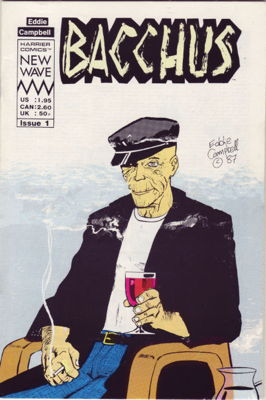
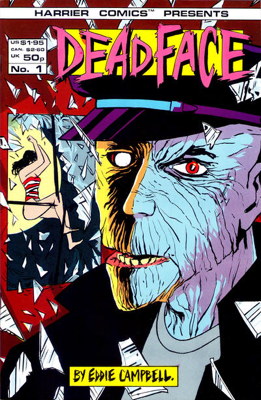
I mean, well, technically I suppose I should have put Deadface first and alphabetized this under “D” but eh, I only think about this particular franchise under the name “Bacchus” anyway.
Deadface and its spin-off/continuation Bacchus were the beginning of a long-running project by cartoonist Eddie Campbell, putting Bacchus from ancient Greek mythology into modern times. Both moody and funny, it was a compelling read, particularly for your pal Mike who’d always been interested in the stories told in these myths and found Campbell’s retelling/reinterpretation of them quite enjoyable.
The Bacchus comics continued on through most of the ’90s in various places and formats, primarily in the series Eddie Campbell’s Bacchus that ran from 1995-2001. There were several short stories that appeared in various anthologies (like Dark Horse Presents) and one-shots and tie-in minis (The Eyeball Kid!) and I read them all, but boy what a series to collect because you never knew where they’d turn up next. There are a couple of omnibii from Top Shelf that appear to collect everything together into one place, which makes things easier.
Anyway, great comics and writing about them makes me want to reread them all, like, you know, I have the time!
The Badger (Capital/First 1983-1991)
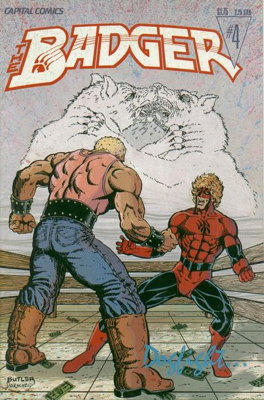 …And there were several one-shots and minis after that initial run. The Badger has come up on the site recently, but let me quote what I said about the character back in 2016 when they were trying again to get the character off the ground:
…And there were several one-shots and minis after that initial run. The Badger has come up on the site recently, but let me quote what I said about the character back in 2016 when they were trying again to get the character off the ground:
“…The Wikipedia description of the character made it sound like a string of clichés, and to someone unfamiliar with the Badger, like presumably a good chunk of folks in today’s comics market, that surely doesn’t do him any favors. A dry description doesn’t accurately represent the actual tone of the book, as I tried to explain in Johanna’s comments. There was an overwhelming sense of…well, just plain weirdness, an off-kilter sense of humor at work in the comic that I could only describe in comparison to writer Mike Baron’s other major series, Nexus. It was wacky when it wanted to be, dead serious when it needed to be, with quirky dialogue and clear storytelling. It was more than the sum of the parts listed in that Wiki entry.”
I would go on to say, as I said again recently, that later revivals didn’t quite capture the same tone as that initial run. Even the initial run had trouble maintaining itself in the latter part of series, but when that comic was running on all cylinders, it was a hoot. I suspect revisiting the series now would turn up some humor that…hasn’t aged well (it’s been noted that one of Badger’s multiple personalities, a gay man, plays off a little better in earlier appearances than later ones). Those early issues, particularly the first 12 or so, are probably the best, and the first issue may be about as good as the Badger gets, probably one of the best debut issues in modern times.
Boris The Bear (Dark Horse/Nicotat 1986-1991)
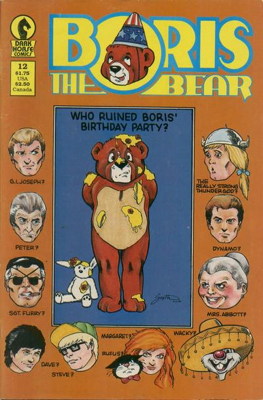 Another series I adored. Began by Mike Richardson, Randy Stradley and James Dean Smith, later taken over mostly by Smith), the initial issue had Boris going after (i.e. outright slaughtering) thinly-veiled parodies of Teenage Mutant Ninja Turtles knock-offs (and other funny animal comics launched in their wake). The next issue went after the giant robot genre, and so on. While parody was always a part of the series, it fairly quickly began to focus a little more on Boris’s life and friends and less on the ol’ ultraviolence.
Another series I adored. Began by Mike Richardson, Randy Stradley and James Dean Smith, later taken over mostly by Smith), the initial issue had Boris going after (i.e. outright slaughtering) thinly-veiled parodies of Teenage Mutant Ninja Turtles knock-offs (and other funny animal comics launched in their wake). The next issue went after the giant robot genre, and so on. While parody was always a part of the series, it fairly quickly began to focus a little more on Boris’s life and friends and less on the ol’ ultraviolence.
It was a polished, professional comic book, but it always had this…amateurish edge to it. Not in the bad way, I hasten to add, but its origins in the waning years of the black and white boom, that touch of “do-it-yourself”-ness, always remained clinging to the comic. That tiny lack of polish was just part of the charm, reminding you this was someone’s personal vision, not just a churned-out piece of cynical marketing.
There were a couple of tie-in series, like color reprints of the early issues, and Boris Adventure Magazine which would focus on the parodies more so than the parent series. And somewhere along the way there was a parody of Boris the Bear in another black and white humor title, the name of which eludes me at the moment, but I think there was some sort of circle closing there.
• • •
Hoo boy these are talking longer to write than I expected! I may skip doin’ them this Friday but I’ll be back Monday to continue the countdown. Thanks for reading, pals, and I’ll see you next time.
Okay, the “votes” as such have been submitted, I tallied the results, and now I shall spend the next, oh, few months or years looking at what you folks had to say were your favorite 1980s comic book series!
Well, maybe not that long, but it’s not going to be “1980S COVERAGE ALL DAY EVERY DAY” here or anything, as I imagine I’ll break things up a bit. But I appreciate everyone participating, and I look forward to talking about the various titles you chose.
Which brings me to a couple of things. One, I’m not going to have a whole lot to say about some titles. It’ll probably be obvious when I come to them, particularly since the first comic I’ll be talking about will be one of those. I just haven’t read everything, nor have I formed any sort of concrete opinion on titles with which I may only be passingly familiar. So please forgive my ignorance in those cases, and chime in with your own remembrances if you’d like.
Two, this is hardly a scientific survey, but over a hundred respondents both here and on Twitter give me a good variety. I think my big mistake was not saying “pick your favorite without worrying about whether or not certain titles already got enough attention.” I should have added the request to not look at previous votes before adding your own, like I do with my prediction posts, but what’s done is done, I suppose. I’ve cut off the voting as of Sunday evening, but if you still want to point out your faves in these comments, feel free!
Still, we have a lot of titles to look at, which should be fun. Well, for me anyway, I don’t know about you guys.
Oh, one more thing…there were lots of votes for Elfquest and Cerebus (both beginning in the 1970s), and Flaming Carrot (technically first appearing in the 1970s) so I did exclude them from the process here. However, they certainly paved the way for what was to come, and to be honest Flaming Carrot was truly FLAMING CARROT in the 1980s, so let’s just call all those Honorary 1980s Indies and acknowledge their importance!
To start with, I’m going to tackle all the single-vote getters…none of which should be considered “lesser” in any way, but should instead be presented as examples of just how varied and interesting the 1980s comic market was. Just imagine (or remember back when!) you could walk into a store and see so many of these new on the shelves. What a time.
Oh, and which title did I vote for? We’ll have to wait and see!
And awaaaaay we go!
ONE VOTE
The Adventurers (Aircel, Adventure, Malibu 1986-1990)
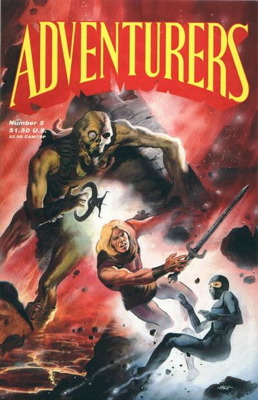 A straight-up fantasy book, from appearances (sorry, didn’t read it, so if I’m missing some nuances, please correct me!), in a time when the sword-and-sorcery thing was slowly on its way out (though Conan was hanging in there). Featuring covers, at least for a while, by Peter Hsu, who had previously worked on the slightly more naked Quadrant and, later, the fantasy title Elf Warrior.
A straight-up fantasy book, from appearances (sorry, didn’t read it, so if I’m missing some nuances, please correct me!), in a time when the sword-and-sorcery thing was slowly on its way out (though Conan was hanging in there). Featuring covers, at least for a while, by Peter Hsu, who had previously worked on the slightly more naked Quadrant and, later, the fantasy title Elf Warrior.
Commenter James says the story and art were well done…despite my teasing about Quadrant, the covers were fine, certainly attention-grabbing. Interior art was by Kent Burles with scripts by Scott Behnke, though the creative team would change as the series went on. Burles would stick around for the most part, it seems.
There were three series over three imprints, with the initial two-issue run from Aircel. That series would pick up with #3 at Adventure Comics, an appropriate place for this title, I’d think. Adventure would reprint #1 of the Aircel run, but not #2, so anyone trying to complete that first series of Adventurers from Adventure and are pulling your hair out trying to find that second issue…well, there you go.
Malibu, the credited publisher on the third series, would issue trade paperbacks of the whole enchilada in 1990. Adventure, Malibu, and Aircel would all be connected somehow, businesswise, though I’m not sure if Aircel was part of Malibu at the time of publication for those first two comics.
Also as James notes, this was a somewhat in demand comic, commanding higher-than-normal prices in those still-in-the-black-and-white-boom days of the comics market. Not as much now, I suppose, so if you were looking to finish your run, now’s the time!
AIRBOY (Eclipse 1986-1989)
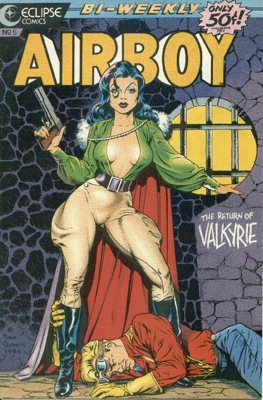 I have read one issue of Airboy, and that was the Airboy and Mr. Monster comic from 1987. I talk about it here, mostly in relation to the 2015 Airboy series (which I do praise a bit there, prior to it going a bit off the rails in later issues).
I have read one issue of Airboy, and that was the Airboy and Mr. Monster comic from 1987. I talk about it here, mostly in relation to the 2015 Airboy series (which I do praise a bit there, prior to it going a bit off the rails in later issues).
That crossover one-shot probably isn’t really representative of the series as a whole, kicked off in 1986 by Chuck Dixon, Tim Truman and Tom Yeates. It was part of Eclipse’s short-lived attempt (along with The New Wave) at having some really inexpensive color comics on the shelves. Well, it got people to pick it up, and they must have liked what they read since it ran a whole fifty issues (plus the occasional tie-in), which ain’t too shabby.
This was a revival of a Golden Age WWII character, but it was new stories so it still qualifies for “new 1980s comic” because I say so. (This is going to be a problem when we get to a later comic that was primarily reprints from previous decades.) It was popular, it had strong back issue demand for quite some time even after the title’s demise, and it’s still remembered fondly today. Not a bad legacy, I think. Nowadays the one issue people ask for most is #5 with the Dave Stevens cover (pictured) for likely obvious reasons.
Akira (Kodansha 1982-1990, republished in the US by Marvel/Epic 1988-1995)
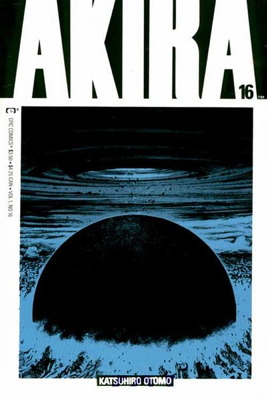 I know Akira primarily from the stunning and influential film based on Katsuhiro Otomo comics (originally serialized in Japan). I somehow was familiar enough with the comic to recognize that a character or two that popped up in the film for, like, a second, were actually fairly prominent in the comics themselves, but that’s what is to be expected when you try to compress a couple thousand pages of comics into a two hour movie.
I know Akira primarily from the stunning and influential film based on Katsuhiro Otomo comics (originally serialized in Japan). I somehow was familiar enough with the comic to recognize that a character or two that popped up in the film for, like, a second, were actually fairly prominent in the comics themselves, but that’s what is to be expected when you try to compress a couple thousand pages of comics into a two hour movie.
It really is a comic I should read, because as amazing as the movie is, I’m certain the comic is even amazing-er, which amazes me that I didn’t pick this up and read it during that Marvel/Epic color reprinting. And I was wondering if that reprint actually included everything from the original manga, and a little calculation shows that the Marvel series totals out to well over 2,000 pages, so I’m guessing so.
I think the problem is that my initial experience with Akira as a comic was seeing it initially with its quite well done coloring. Not that I thumb my nose at black and white books, obviously, but the color is so much a part of how I imagine the story that seeing it in its original form feels…well, weird. Dark Horse later published Akira in six volumes more closely approximating the original work, with right-to-left pages and b&w interiors. Those are out of print now, though it appears Kodansha now has similar editions available for the U.S. market.
Of note are the last two issues of the Marvel/Epic run, which include new “tribute” stories/pin-ups by Western creators that I don’t think have been reprinted elsewhere, but please correct me if I’m wrong. Those Epic issues are still in enormous demand, as it remains the only full-color (and left-to-right reading) version of the story…I mostly blew through a recently-acquired run in short order.
And apropos of nothing, pal Cully (whom you see in my comments occasionally) told me long ago that his daughter, then just a little squirt, would refer to the animated Akira as the “help-me help-me movie,” which I believe is a fair summary.
• • •
If any of you have your own thoughts on these titles, please drop ’em in the comments. I’ll continue my overview of your favorite comics (more one-voters!) later in the week, and hopefully next time I can spend less time explaining what I’m doing here and more time covering more series! Thanks for chiming in, everyone, and I’ll see you all soon.
Okay, still taking your “Fave ’80s Title” picks, at least through the weekend. I’ll tally things up and start discussing stuff on Monday.
And I think I’ve caught up on responding to the comments for the last few posts. I’m down to this most recent one and re: the requests for favorite ’70s/2000s titles…oy, let me get through the ’80s stuff first. I am but a mortal man.
Also, the question was asked “why were Continuity Comics great-looking but not so greatly-written” and I think I wasn’t much of a fan of the coloring, either. Though I may be overlaying my memories of some of the, well, appalling recoloring of some of Neal Adams’ work at DC onto the Continuity output, so maybe I’m confusing the two. But as to “why the writing,” I don’t know. It’s like a whole company’s output was Batman: Odyssey. And, you know, some people really liked those comics…certainly sold plenty of them when they were coming out.
LouReedRichards asked if there was a good jumping-on point for Love and Rockets or just start at the beginning. Well, starting at the beginning is the ideal, but even just picking up the newest issue will give you plenty to enjoy. Maybe you won’t know all the characters and situations but it’s so well done you can enjoy it for what it is.
Alternatively, you can pick up any of the collections/graphic novels and just dive in. It’s Good Stuff all around. Probably not the most helpful response, but honestly sampling an issue will make you want to search back and find more, and that joy of discovery can be part of the fun of enjoying these comics.
Okay, I think that’s all I have to say today…except along the way Paul asked if I’m going to revive new content for my Patreon. And the answer is “I plan to” when I can find more time, which is the trick right now. I do appreciate the support folks give me there, so don’t think I’m taking that for granted. It all helps, believe me.
Thanks for reading, pals, and I’ll be back Monday for the Big 1980s Countdown, Part One of Apparently One Thousand.
Hi pals! Still looking for your single, ONE, UNO favorite title from the 1980s! Drop in your choice…and even if your pick’s been mentioned, drop it in anyway…I’ll be tallying “votes” and seeing which book came out on top!
I’ll probably start covering those next week, but let me continue going through some of your older comments and questions:
Cassandra Miller mentioned
“God, those years in the 1980s sure were a time…I recently (last year) uncovered some old obscure parody comics from then, ‘ElfTrek’ and ‘Secret Doors,’ and just had a blast reading ’em. Some of the jokes are seriously dated/would be impossible for anyone under 48 or so to get, the art is a bit crude, but they were just plain fun. The absolute freedom in so many of those b&w boom comics was so incredible.”
One thing I sort of miss from the old job is having access to the remnants of ’80s black and whites like, say, Elftrek:
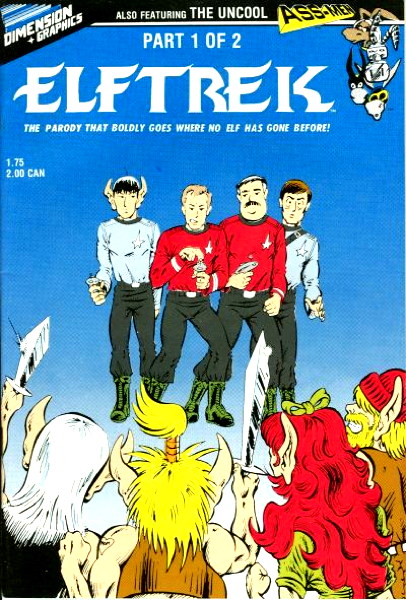
…where these things just sat in the back issue bins, unsold and unsought-after, and we just rolled our eyes at being burdened with these books and did not appreciate the bounty that existed at our fingertips. I touched a bit on this in the post about Az, in which I noted that I missed that period of time where just about anything could get published and put on a rack right there next to X-Men and Batman. Granted, a lot of it was…not of interest to me, to be nice, but there was so much imaginative fun getting out there.
Elftrek is a comic I came across occasionally at the old job, but never actually looked inside far as I can remember. You’d think, in those early blogging days, I’d at least have pulled a panel or three from a copy to throw on this site for the amusement of all. Only two issues (collect ’em all!) so I may have to keep an eye out for those.
One thing about being a comics dealer is that the excited frisson of discovered some new weird book on the shelf is muted by more commercial and economic concerns. But remembering weirdo comics that I missed the first time around, or even getting my hands on them in my own store…a nostalgic twinge reminiscent of that feeling does occur, putting me just slightly in mind of scouring the shelves looking for that oddball book to round out my handful of regular buys.
• • •
Donald G speaks clearly into the microphone, saying
“William Messner-Loebs, who wrote Comico’s JONNY QUEST adaptation back in the eighties, pronounces the company name ‘koh-MEE-koh.’
“While a lot of YouTube video essayists have some idiosyncratic pronunciation quirks when it comes to common, everyday English words and proper names, ‘koh-MEE-koh’ is not a YouTube invention.”
I have literally said it no other way in my entire time sellin’ funnybooks for a living. I don’t know if I ever heard anyone say it “kah-mek-OH” back in those pre-World Wide Web days. I’m not sure how the “koh-MEE-koh” pronunciation was passed down to me, either via something in one of the comics or maybe the news/reviews mags or fan press, or if that’s just how my old boss pronounced it. But that’s the way I’ve always said it, that’s the say I say it now, and that’s how I correct people on the rare occasion I hear someone say it the wrong way now. Yes, I correct people on how to say “Comico,” THAT’S THE HILL I’M DYING ON.
• • •
For anyone interested in some contemporary reporting on a seminal comics publisher, Customer Sean dropped
this 1982 article into the comments regarding Pacific Comics.
• • •
On to the
next post, where
pal Nat sez
“One thing it’s hard to realize now is that Pacific was using a wider color palette then the other comic publishers at the time, and this made their issues just scream at you from the rack showing colors that you never really seen in a comic book before.”
I mean, not much to add to that. The covers on Pacific books were quite nice and distinctive, important in catching that customer eye from amongst all the other books on the rack.
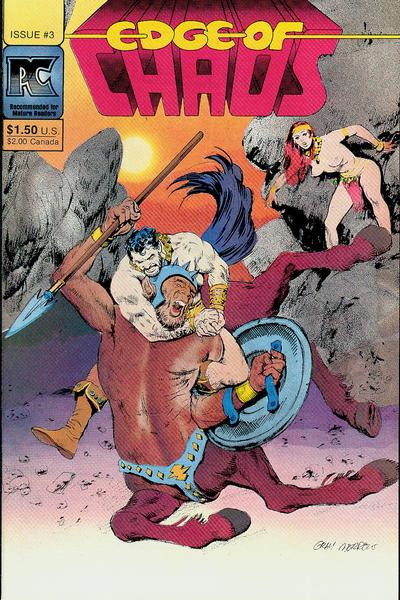
I’m reminded someone of how early Marvel books had covers colored in relatively muted, dark tones, versus the brightly-colored images of their cross-town rivals.
• • •
Moving on the aforementioned
Az post, a few folks noted another early Comico release
Slaughterman:
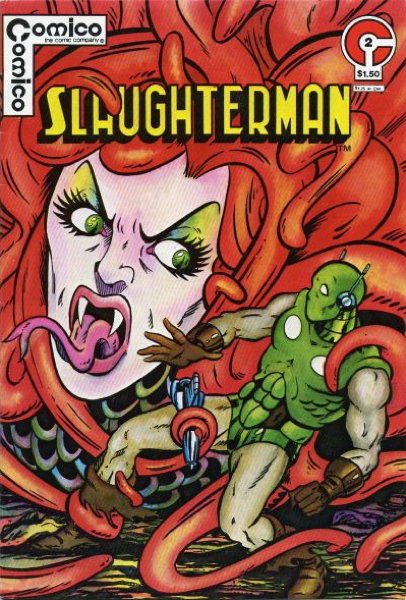
…And honestly, aside from the pretty name, I don’t remember really anything about the comic or the character. Customer Sean does bring up this good point about that period in Comico’s history:
“I would say that the very early Comico comics have a quasi-underground comix art aesthetic going on, which makes its first wave of characters–Az, Skrog, and Slaughterman, very bizarre and outlaw looking for early ’80s comics.”
…and I’d say that’s pretty spot-on. Even if the contents of the books could be amateurish and a little crude, the cover designs (and slightly larger dimensions) were on-target and definitely stood out as something different. “These Aren’t Your Daddy’s 1980s Comics!” they almost seem to shout.
I did own the three original Grendel issues which just had the most beautiful covers, and boy howdy these books were red hot at one point. They still command a pretty penny now, but back then the demand was constant and just slightly desperate, almost. I wish I’d kept them…I gave them up for sale some time ago, and was satisfied with owning the Dark Horse hardcover that reprinted all that early material along with the covers. It’s a nice book, but not the same as having those three issues which were attractive bits of artistic objects in and of themselves.
• • •
Okay, back Friday for more ’80s talk! Thanks for reading, gang!
Why, he asks you a question, of course!
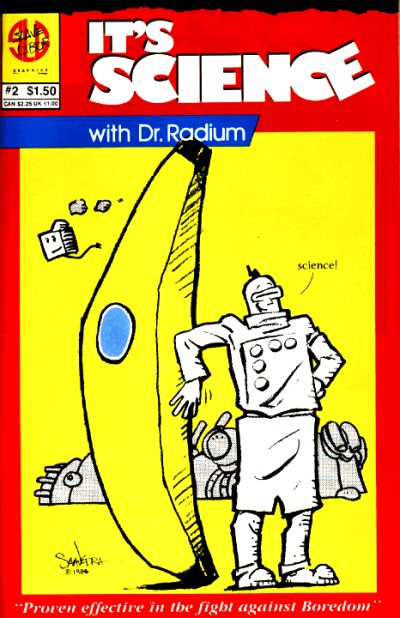
PICTURED: a 1980s comic
Given what we’ve been chatting about here lately, I’d like to know…what’s your favorite 1980s independent comic?
Some ground rules/definitions here:
- Has to have at least started in the 1980s and have released at least a portion of its run in that decade. Say, like, a year’s worth of books…I’m not asking about books that started in December 1989. You know what we’re talkin’ about here.
- …Which also means I’m not looking for one-shots. I mean actual series, at least three issues long.
- JUST ONE BOOK! I don’t want a list of, like, five books as a five-way tie or “here’s my second choice” or anything. Put your nickel down on a single title. Yes, I’m cruel and heartless, you should know that by now.
- For the sake of discussion, “independent” means anything not published by Marvel or DC. HOWEVER, I will allow comics from Marvel’s Epic Comics division since those are so quintessentially ’80s (and being creator-owned, often moved on to other publishers).
- Black and white boom titles can be included, so if your favorite 1980s series is Samurai Penguin, go right ahead and throw it in the ring. …What? I like Samurai Penguin.
- You don’t have to explain your choice…you can just post a title and go, that’s fine. But if you want to write a few lines talking about it, that’s okay, too. A few lines, Sean.
- Comic magazines are also okay. Anything that was a periodical is fine, so I’m going to leave graphic novel series out of this particular discussion.
- Did I say just pick ONE BOOK? ONE TITLE ONLY, don’t give me a list, or “here are my runners up” or “here’s the pool of titles from which I had to decide” or anything. C’mon, gimme a break.
Okay, that’s enough of my draconian laws. I look forward to your ONE TITLE ONLY and OPTIONAL BRIEF EXPLANATION being left in my comments!
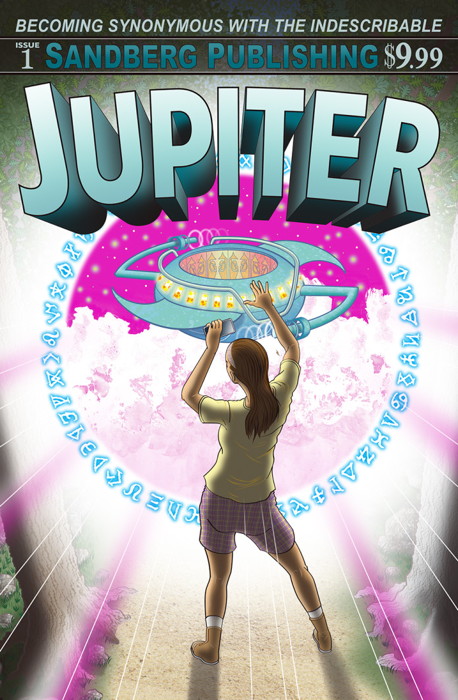
Gird whatever needs girding, as Jason Sandberg is bringing new Jupiter print comics to you via Indiegogo! The campaign is already fully funded, but you still have nearly a month to get in there and order some great funnybookin’ for your own home or office. Lots of swell add-ons to be had as well! I’ve been a longtime fan of Jupiter and pal of Jason, and this work gets my highest recommendation!
I’ve written about the original late-1990s print version of Jupiter here, though I don’t think the Pelasgus feature is continuing. Maybe if we all demand a Pelasgus graphic novel….
You can hear Jason talk about his comic and the Indiegogo campaign on the Longbox Heroes podcast with Todd and Joe. I know the interview isn’t noted in the description but it’s there, I promise! I’m listening to the interview in episode #651 again right now. And at one point the three of them start talking about my favorite topic — me! — so definitely worth a listen.
• • •
Okay, to continue the 1980s indies talk…yes, I’ll get back to some of your older comments, but let me react to a couple newer ones that
aren’t…parody songs? Is there something in the water? What’s going on with you nuts.
Customer Sean asked about maybe including Marvel’s Epic imprint or Dark Horse into my indie comic rankings. Well, Epic might be okay, even though it’s not really an “indie” in the sense we mean it here, and Dark Horse is still an ongoing concern and I was trying to stick to companies that are defunct, or at least no longer the same operations they were back in the ’80s. I think both the Comico and the First Comics brands returned within the last few years, but I’m not sure of their current statuses.
It’s funny…this puts me in mind of a long-ago article in The Comics Journal #98 (May 1985) by Jan Strnad, “The Alternative Comics Cadaver Derby.”
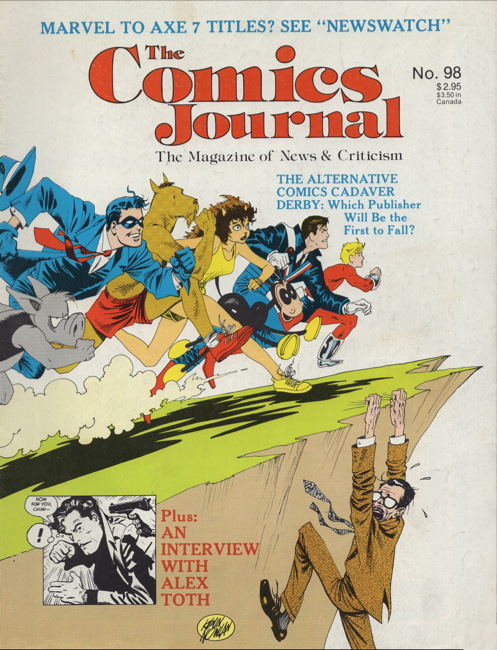
Following the demise of publishers Capital Comics and Pacific Comics, Strnad wondered who would be the next company/cpmpanies to fall, and thus lists several then-extant publishers and lays the odds on who would “win” by dying off first.
The general premise of the commentary is that the closer to being like Marvel Comics they were, the more likely they would “lose” the derby by surviving. And conversely, the higher quality of the material they publish, the more likely they were to “win.” A bit cynical, a bit smartass-y, a bit…well, right, kind of.
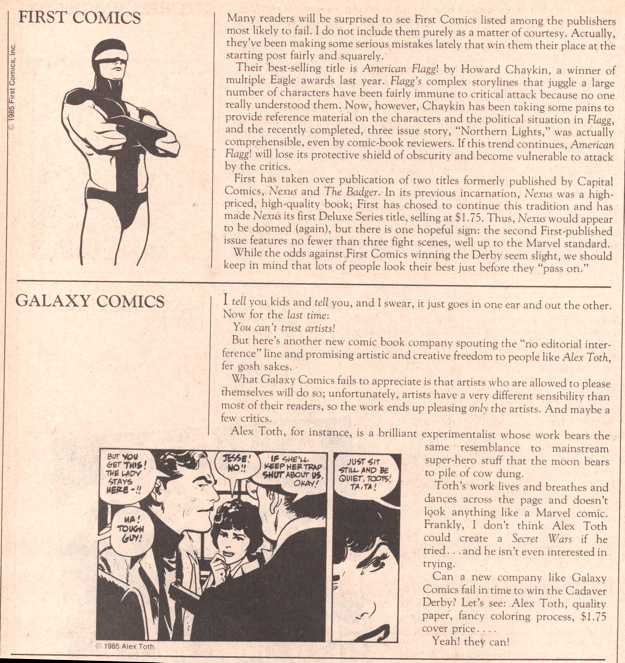
About three quarters of the companies listed are still around…including the Journal’s publisher Fantagraphics, which has managed to stick around despite publishing good comics.
Anyway, was reminded of that article, and wondered a bit what a modern version of that would be like — NOTE: NOT INVITING GUESSES AS TO WHAT CURRENT PUBLISHERS WILL GO OUT OF BUSINESS. I’m just curious what new factors would go into deciding who might live/who might die. Obviously the companies with the most variant covers and the highest ratio of CGC-slabbed investibility would be the big “losers” of that derby now.
Fine sarcasm is a lost art.
Sean also mentions looking back at the black and white boom, and I’ve said before I was only on the retail side of things for the tail end of that era. Mostly I was a wanderer through the wreckage, observing the boxes of unsold comics, the countless Teenage Mutant Ninja Turtles and Dark Knight Returns parodies that came and went unsold, the b&w publishers slowly petering out or pivoting to color, the poor bastard at that one convention who had a longbox full of nothing but Shadow of the Groundhog.
Thankfully, my former boss, who did ride out that era, avoided overordering and getting stuck with the terrible comics cranked out to take advantage of the boom. But I read a lot about it as it was happening, saw it on the shelves (not to as great extent at my soon-to-be place of employment, but certainly saw it elsewhere), so I imagine I could say something about it. I mean, I suppose I just did. I also wrote about Solson Comics last year, so I’ve at least served part of my sentence.
But that’s enough for now. See you all next week. And ease up on the song parodies in the comments, geez louise.
So a discussion attempting to rank some of the recently-discussed-here comic book publishers broke out in the last post’s comments, so I thought I’d chime in with my own experiences and opinions and such. Since, you know, it’s my blog an’ all.
I’m just sticking to these four: Comico, First, Eclipse, and Pacific, since they’re all defunct (or at least the “classic” original 1970s-1990s versions of them are. I’m aware there have been newer revivals of sorts of a couple of these companies, but those aren’t being included here.
Anyway, #4 on the list is…
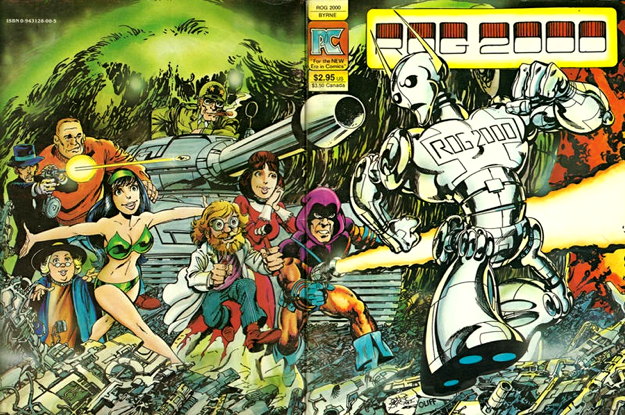
…Pacific Comics. I suppose now is as good time as any to say “I liked the output from all these companies,” so being #4 on the list isn’t a bad thing. It’s only here because, personally, my interaction with the publisher while it was extant was minimal. I told you recently that the first book I bought from them new off the stands was the first issue of Berni Wrightson: Master of the Macabre #1, and I bought one or two other comics new from them as well.
Aside from that, my interaction with their publications mostly happened after the fact, fishing various titles out of back issue bins. Rog 2000 (pictured above), a reprinting of some of John Byrne’s work, was an early get. I bought a single issue each of Alien Worlds and Twisted Tales new, and picked up the rest as back issues later. And as I said before, my first Groo was the Eclipse one-shot and I went back and picked up the Pacific Groos later.
I will give Pacific this…I still have distinct memories of the newsstand I attended having, like, Captain Victory and other Pacific books on their spinner racks. Why this newsstand was getting direct-sales stuff, I don’t know (I also bought my Don Rosa’s Comics & Stories there, as well as the last few issue of Comic Reader), but that was one of the ways I began to realize “oh wait, there’s more than Marvel and DC out there.”
Onto #3, which is…
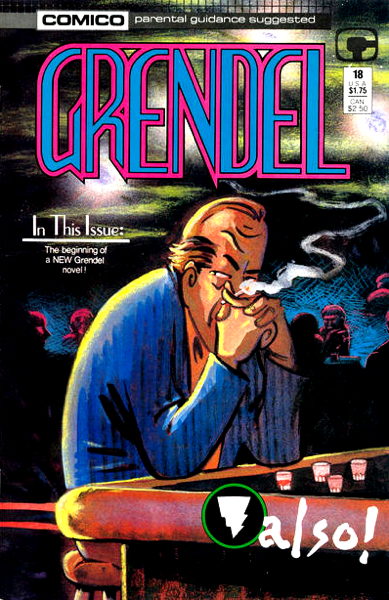
…Comico, where I bough stuff like Grendel, Mage, Jonny Quest and other old favorites new off the rack. I certainly enjoyed what I got from them, and they put out quality product, but the #3 ranking is mostly a numbers game, in that I bought more from the next two companies than I did from Comico.
Speaking of which, #2 is…
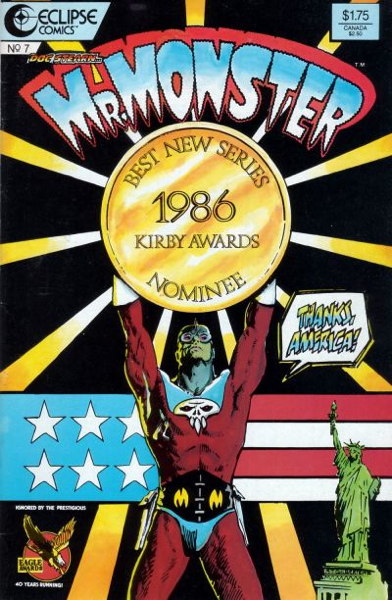
…Eclipse, where I picked up a lot of books, mostly new off the shelf, with the occasional after-the-fact-er (like that Stewart the Rat grapic novel I mail ordered from Eclipse honcho cat yronwode post the company’s fall.
This is where Zot! lived. And Mr. Monster. And the early issues of Ms. Tree. And of course Miracleman, the initial U.S. release of Alan Moore’s Marvelman, came from here, too. They also continued some of the Pacific Comics titles that were interrupted mid-stream, like the aforementioned Berni Wrightson: Master of the Macabre. This company gave me so many wonderful, innovative, influential and memorable comics that I still love even today.
Which is why the #1 company of these four only made the top spot by the slimmest of margins…
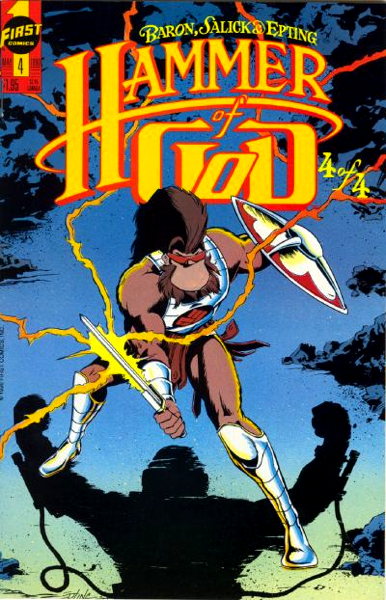
…First Comics. Which is probably at he top for the same reason Pacific is at the “bottom” — just the sheer quantity of it all. Not necessarily saying “more is better,” but I felt like I was in there near the ground floor of the company’s start, and I picked up so much from them over the years that I enjoyed. First was such a consistent presence in my new comics purchases for so long, a dependable provider of entertainment, that (as I think someone said in my comments) may not have been the most groundbreaking work, but it was certainly fun work.
Nexus, Badger, Grimjack, Jon Sable Freelance, American Flagg!, Dreadstar, a bunch of their wonderful CLassics Illustrateds…they didn’t have quite the number of titles Eclipse did, but it was nice to have such long runs on these books to watch the characters and situations grow and develop.
Though I have to be honest…ask me on a different day and I may say Eclipse is #1 for the sheer variety of content they provided. I’m just more in a First Comics mood as I write this, I guess.
Besides, First Comics had Teddy Q as their mascot:
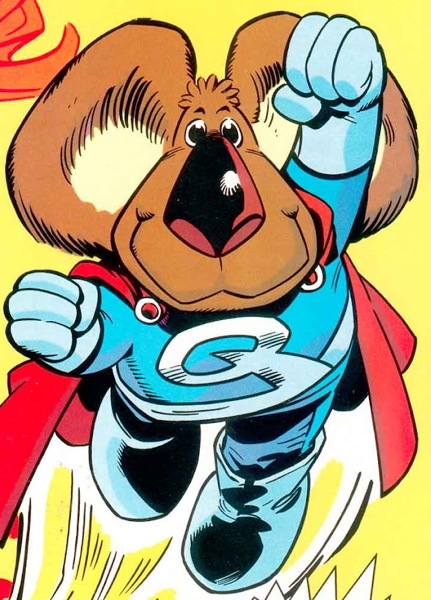
…and that’s hard to beat, you have to admit.
So as our 1980s comics symposium continues, I wanted to cast an eye over at the early Comico Comics release. I was inspired by a recent tweet I made in which I stated, truthfully, that the Comico release Az (by the late Phil Lasorda) would just occasionally come to mind. I’ve never read it, never owned a copy (aside from having them in the back issue bins at the shops), but its…weirdness just stuck in my head.
Here’s a better look at the comic:
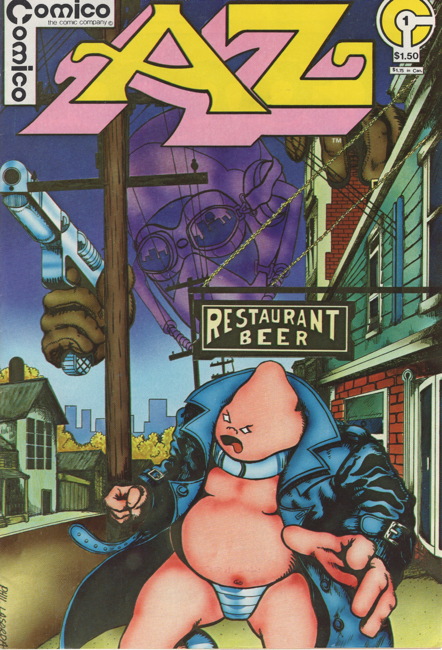
And yes, at pal Cathy’s request for more information, I took it home and I read it for the very first time, 40 years after its release.
When I was a kid, I loved the idea of non-professionals putting together their own creative projects in whatever field they decided upon. In my case, I was most interested in seeing what other people my age were doing in fiction writing or comic book drawing, as those were the fields I had interest in as well. There was…some book at my local library (the library I ended up working at for a while) that collected together a bunch of short stories written by schoolkids that I enjoying reading over and over again, and there was a book published in the mid-1970s called Make Your Own CXomics for Fun and Profit that…well, don’t hold out high hopes for profits, friends. But there are lots of examples contained therein of kids doin’ it for themselves and I found it wonderfully inspiring, checking it out from the library over and over. I’ve since picked up a copy of my own, and they’re relatively inexpensive.
So basically I’ve had an interest in amateur work like what you see here in Az, a sort of unfettered approach to putting your imagination on paper and getting it out there for people to read, without the constraints that could be put upon the project by larger publishers. It’s rough around the edges, I’m not sure about the setting for the story (more on that in a sec), there’s a full page drawing with a waitress in the foreground whose nipples are very carefully delineated beneath her shirt which is — a choice…like I said, unfettered.
Aside from that last bit about the nipples, which, honestly, that was out of nowhere, this isn’t a terrible comic. It sets up the premise, introduces our hero, tells its story…not polished in the slightest, but retains a measure of charm anyway.
In brief, the comic takes place on another planet, which might as well be Earth, what with all the humans, newspapers and phone booths and a Main St.:
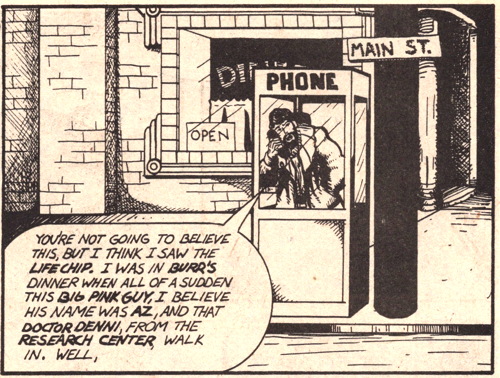
…and there are some bad guys (Skyriders, from the planet…well, Sky) who are after the Lifechip, a device that can impart life upon anything. Including this office chair Az’s scientist buddy shows him:
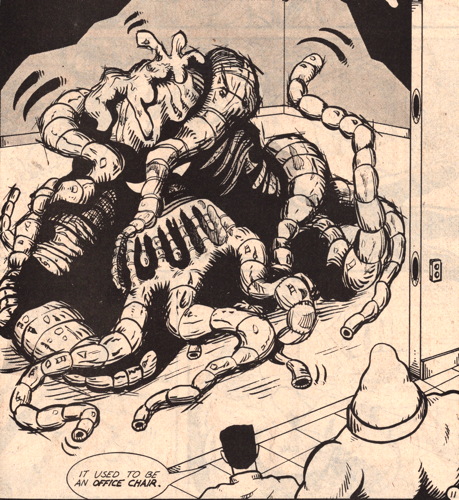
And speaking of Az, he’s the last(?) of his race, hanging out on this planet that is definitely not Earth and helping out the lab and occasionally knocking a bad guy’s head around, oh, and also is horny and trying to find another of his race so they can repopulate his home planet. Which presumably is why he tools around wearing a bikini bottom because once he gets his chance with a similarly-specied lady, we doesn’t want a whole lot of undressing to get in the way.
Now, to be fair, the planet’s setting may have been intended to been explained as “Earth humans colonizing another planet” which I think is a fair read of the situation. Unless it’s explaining in the second, and as it turned out, final issue of the series.
One of the main reasons that Az stuck in my mind was the whole aesthetics of it all. These very early Comico comics, much like I said about early Cerebus, I enjoy as just pure physical objects. The covers, the fact that they were at a slightly larger trim size than most comics (like early Tick comics)…they certainly stood out on a rack. Nothing else looked quite like them.
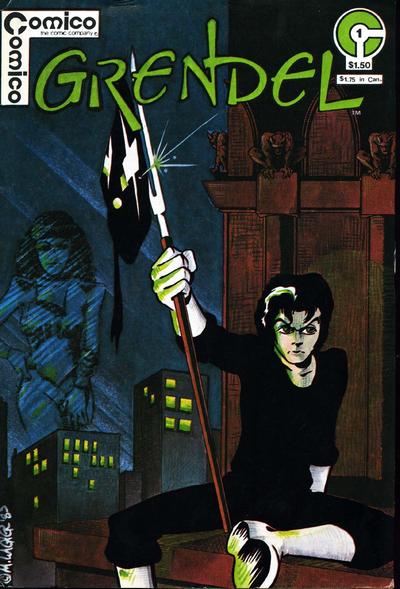
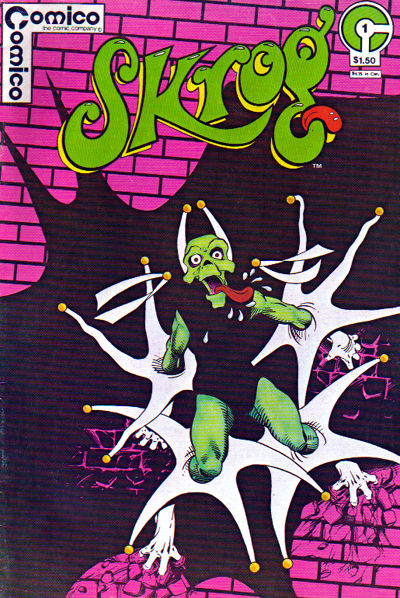
Never read Skrog, did read the three issues of Grendel from this time…a less technically proficient Matt Wagner was putting these out, but even then he had the chops to make an entertain and visually distinctive product. Both beautiful and weird, this particular format gave a unique look to these comics among the others on the rack, and something was lost when Comico shifted to more traditional-looking publications.
And it’s an additional shame Mr. Lasorda never got to complete his vision. Maybe the comic was a little rough and clunky, with the occasional (well, one, really) inappropriate moment, but seeing someone not get to finish his creative endeavor. Which, of course, is a common problem even today, in a marketplace that isn’t always necessarily friendly to anything awkward and strange.
« Older Entries
Newer Entries »

 Well, here’s another comic which had an issue I could have bought from the old shop for relatively dirt cheap, but just never got around to it. It’s that first issue, pictured right here, which I wanted for the
Well, here’s another comic which had an issue I could have bought from the old shop for relatively dirt cheap, but just never got around to it. It’s that first issue, pictured right here, which I wanted for the  I like Mark Evanier’s writing. I like Dan Spiegle’s art. So why didn’t I read this series? Because I’m a dummy, I guess.
I like Mark Evanier’s writing. I like Dan Spiegle’s art. So why didn’t I read this series? Because I’m a dummy, I guess.  Okay, this series I read every issue (and the follow-up
Okay, this series I read every issue (and the follow-up 

 …And there were several one-shots and minis after that initial run. The Badger has come up on the site recently, but let me quote what I said about the character
…And there were several one-shots and minis after that initial run. The Badger has come up on the site recently, but let me quote what I said about the character  Another series I adored. Began by Mike Richardson, Randy Stradley and James Dean Smith, later taken over mostly by Smith), the initial issue had Boris going after (i.e. outright slaughtering) thinly-veiled parodies of Teenage Mutant Ninja Turtles knock-offs (and other funny animal comics launched in their wake). The next issue went after the giant robot genre, and so on. While parody was always a part of the series, it fairly quickly began to focus a little more on Boris’s life and friends and less on the ol’ ultraviolence.
Another series I adored. Began by Mike Richardson, Randy Stradley and James Dean Smith, later taken over mostly by Smith), the initial issue had Boris going after (i.e. outright slaughtering) thinly-veiled parodies of Teenage Mutant Ninja Turtles knock-offs (and other funny animal comics launched in their wake). The next issue went after the giant robot genre, and so on. While parody was always a part of the series, it fairly quickly began to focus a little more on Boris’s life and friends and less on the ol’ ultraviolence.  A straight-up fantasy book, from appearances (sorry, didn’t read it, so if I’m missing some nuances, please correct me!), in a time when the sword-and-sorcery thing was slowly on its way out (though Conan was hanging in there). Featuring covers, at least for a while, by Peter Hsu, who had previously worked on the slightly more naked
A straight-up fantasy book, from appearances (sorry, didn’t read it, so if I’m missing some nuances, please correct me!), in a time when the sword-and-sorcery thing was slowly on its way out (though Conan was hanging in there). Featuring covers, at least for a while, by Peter Hsu, who had previously worked on the slightly more naked  I have read one issue of Airboy, and that was the Airboy and Mr. Monster comic from 1987. I talk about it
I have read one issue of Airboy, and that was the Airboy and Mr. Monster comic from 1987. I talk about it  I know Akira primarily from the stunning and influential film based on Katsuhiro Otomo comics (originally serialized in Japan). I somehow was familiar enough with the comic to recognize that a character or two that popped up in the film for, like, a second, were actually fairly prominent in the comics themselves, but that’s what is to be expected when you try to compress a couple thousand pages of comics into a two hour movie.
I know Akira primarily from the stunning and influential film based on Katsuhiro Otomo comics (originally serialized in Japan). I somehow was familiar enough with the comic to recognize that a character or two that popped up in the film for, like, a second, were actually fairly prominent in the comics themselves, but that’s what is to be expected when you try to compress a couple thousand pages of comics into a two hour movie. 























